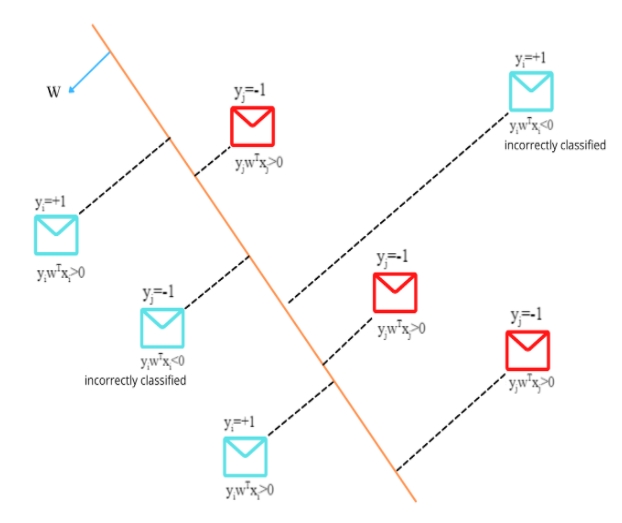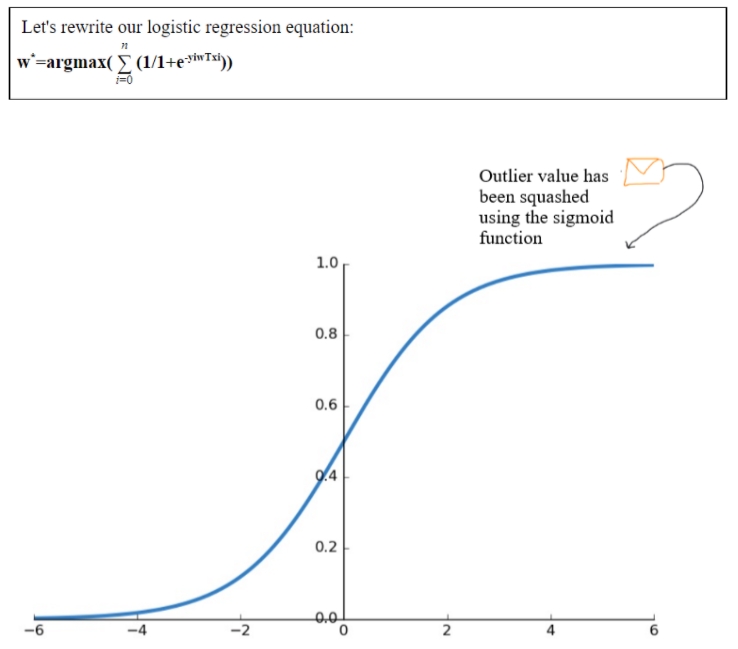Geometrical Approach To Understand Logistic Regression
This article was published as a part of the Data Science Blogathon
Introduction
Logistic Regression is another statistical model which is used for binary classification. It’s named “Regression” because the underlying technology is similar to “Linear Regression”.
Here in this article, we will discuss:
-
Understanding the Basics(Logistic Regression).
-
Formulating the equation(finding better Hyperplane).
-
The solution to the Outlier Problem(Sigmoid).
-
Usage of Monotonic Function(log).
-
Need of Regularization(Lambda).
-
Getting started with the Code(Logistic Regression vs SGD with log loss).
Understanding the Basics
Let’s say we have a problem with spam emails and we want to keep the Non-spam(Ham) in the Inbox and send the Spam to the Spam folder
.png)

Fig 1:Spam and Non-Spam email
We have two types of email Spam and Ham, let’s look at the different features of spam email. The spam email contains
-
Unfriendly domain names
-
The number of appearances of words “loan”,” amount”
-
Spelling mistakes
There will be lots of other features but for now, let’s stick with these.
If we plot the number of times the word “loan” appears on the email on the x-axis and the spelling mistakes on the y-axis we get a pretty decent graph where the Spam and Ham can be separated using a line. And this is what logistic regression is. Basically, we want data that is linearly separable into two classes.
e.g. Here we want to separate Ham and Spam, for this, we need good features which help us in the classification.
Fig 2:Plot of two features
Formulating the equation
Now if the data(i.e. all emails) is linearly separable then a line can separate the data points(each email) into two classes(Spam and Ham). For humans, it’s easy to plot the line in the 2D chart, but for computers, we must follow sets of instructions.
So let’s consider the Ham as positive class “+1”, Spam as negative class “-1” and we have “n” number of features.
In 2-D the equation of the line is : w1x1+w2x2+w0=0
In 3-D the equation of the plane is : w1x1+w2x2+w3x3+w0=0
In n-D the equation of the hyperplane is => w1x1+w2x2+w3x3+……….wnxn+w0=0
=> [w1,w2,w3……….wn]T[x1,x2,x3……….xn]+w0=0
=> wiTxi+w0=0
If the hyperplane passes through the origin then w0 becomes 0 then the equation becomes wiTxi=0. Now our task is to find the hyperplane that separates the data points.
Let’s construct a hyperplane and consider a normal unit vector “w” consisting of randomly selected values(wi) for “w”. Now we want to find out how many data points have been correctly classified by this hyperplane.
For this we will take the help of the “equation of a point from the hyperplane” i.e di= wTxi/||w|| since we are considering w as normal unit vector(||w|| =1), therefore di= wTxi
Now if the data points are in the same direction of the normal vector then it will belong to the positive class else it belongs to the negative class.
Let’s consider
-
A positive class data point xi which is in the direction of the normal vector, then wTxi will be greater than 0 and if we multiply it with the class label yi=+1 then yiwTxi>0
-
A negative class data point xj which is in the opposite direction of the normal vector then wTxj will be less than 0, since yj=-1, therefore, yjwTxj>0
- A positive class data point xi which is in the opposite direction of the normal vector, then wTxi will be less than 0 and the class label yi=+1 then yiwTxi<0 i.e data point has been incorrectly classified.
Fig 3:How hyperplane separates the data points
From the above hyperplane h1 if we sum all the data points
Let yiwTxi=1 for correctly classified and -1 for incorrectly classified
sum(h1) = 1+1+1+1+(-1)+(-1)
= 4
Suppose if we have another hyperplane h2 where the sum(h2) is equal to 5 then h2 is a better hyperplane than h1
So, we want the best hyperplane which minimizes the number of misclassifications and maximizes the sum.

The solution to the Outlier Problem
Now, if we have an outlier on either side of the hyperplane then it will impact the sum. Hence it will impact the selection of the best hyperplane.
For example:

Fig 4:Outlier affecting the hyperplane
Even Though the hyperplane separates the data points correctly, the summation gets impacted by the outlier.
Since wTxoutlier >> wTxcorrectly_classifier therefore, yiwTxoutlier will reduce the overall sum for that hyperplane.
To deal with the outliers which impact the values of w, we will be using the sigmoid function.
Sigmoid(x)=1/(1+e-x)
Lets us assume we have an outlier then wTxoutlier >> wTxcorrectly_classifier
Now if we use the sigmoid function then sigmoid(wTxoutlier) << wTxoutlier
When the value of wTxoutlier becomes larger it tapers it off, the values of wTx are squashed from [-infinity,+infinity] to [0,1].

Fig 5:Sigmoid function and how it helps to reduce the value of outliers
Monotonic Function
We know that a monotonic function increases with increasing the value of x and if a function is monotonic then when applied a monotonic function retains the same maxima or minima i.e
- x increases then fmonotonic(x) increases (i)
-
Argmin fmonotonic(x) = Argmin gmonotonic(fmonotonic(x)) (ii)
-
Also we know that Argmax – f(x) = Argmin f(x) (iii)
-
Log is also a monotonic function and log(1/x) = -log(x) (iv)
Our logistic regression equation: w*= argmax(summation_i=0_to_n(1/1+e-yiwTxi))
Need of Regularization
We have learned how these functions are being used to understand the data and how to overcome various issues. Now let us understand one most important topic known as Bias and Variance Tradeoff.
Suppose we have a dataset contain emails. Now we have got an email for classification which contains the word “loan” multiple times. Our model directly classified it as “Spam” because it contains the word “loan”. Optimizing the logistic regression loss function, our model has learned that any email contains the word “loan” multiple times is “spam”. This is called overfitting i.e. high variance. We are trying to learn everything from our training data which causes our model to overfit.
Now using regularization significantly reduces the variance without increasing the bias. Regularization refers to the act of modifying a learning algorithm to favour “simpler” prediction rules to avoid overfitting. It modifies the loss function to penalize certain values of the weights.
Let zi = yiwTxi
=> zi-> + infinity, then exp(-zi) -> 0,
Log(1+exp(-zi)) -> 0
w* = 0
If the selected “w” classifies all the training points correctly and if zi tends to “- infinity” then the selected “w” is the best “w” on training data. This is a condition of overfitting as the training data may contain outliers to which our model has been perfectly fitted. So, we will add the regularization to deal with the problem.

Here “lambda” is a hyperparameter.
-
If lambda = 0 then the loss term optimization results in an overfitting model i.e. high variance
-
If lambda is larger then the loss term diminished and this leads to an underfitting model i.e. high bias
.gif)
Fig 6:Logistic Loss vs Regularization
The regularization term will constrain w from reaching “+infinity” and “-infinity”.
We can also use L1 regularization which induces sparsity(most of the elements of the weight vector are zero) into the weight vector. The less important features vanish in Logistic Regression with L1 Regularization while using L2 the weight for the less important features becomes small but remains non-zero.
Getting Started with the Code
Let’s understand the code of the Logistic Regression
-
-
Using Logistic Regression, which by default uses Gradient Descent. Here “lambda” is a hyperparameter. Here “lambda” is hyperparameter C=1/lambda and as C increases it will overfit and as C decreases it will underfit.
from sklearn.datasets import load_iris from sklearn.linear_model import LogisticRegression #Importing the Logistic Regression and iris dataset X, y = load_iris(return_X_y=True) clf = LogisticRegression(C=0.01).fit(X, y) #Setting the hyperparameter for the Logistic Regression and #training the model clf.predict(X[:2, :]) #Predicting the class for the data point clf.predict_proba(X[:2, :]) #We can also predict the probability of the class
- Using Stochastic Gradient Descent
-
By simply changing the loss parameter we can easily switch between different Classifiers. For logistic regression we will use loss=” log”, for SVM we will use “Hinge” and so on.
from sklearn.linear_model import SGDClassifier #Importing the SGDClassifier X = [[0., 0.], [1., 1.]] y = [0, 1] clf = SGDClassifier(loss="log") #Setting the parameter loss=”log” for Logistic Regression clf.fit(X, y) #Training the model clf.predict([[2., 2.]]) #Predicting the class for the data point
Conclusion
Logistic Regression performs well when the data is linearly separable but in the real world, the data is rarely linearly separable. It is less prone to overfitting but we should consider using regularization techniques to avoid overfitting.








